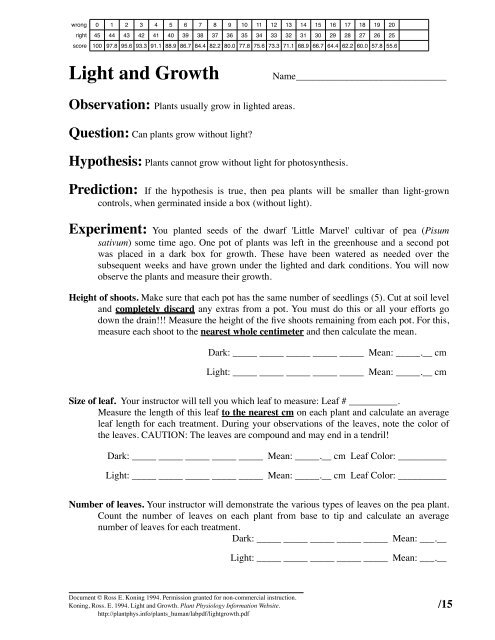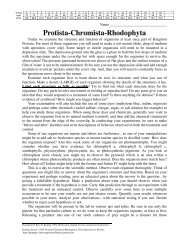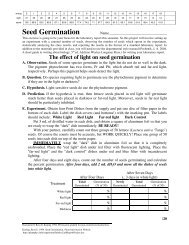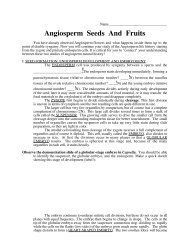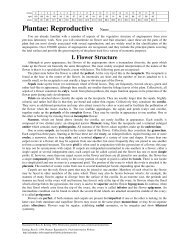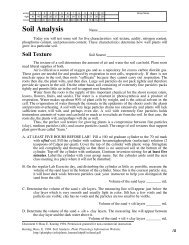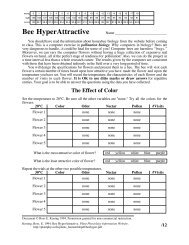Light and Growth - Home Page for Ross Koning
Light and Growth - Home Page for Ross Koning
Light and Growth - Home Page for Ross Koning
You also want an ePaper? Increase the reach of your titles
YUMPU automatically turns print PDFs into web optimized ePapers that Google loves.
wrong 0 1 2 3 4 5 6 7 8 9 10 11 12 13 14 15 16 17 18 19 20right 45 44 43 42 41 40 39 38 37 36 35 34 33 32 31 30 29 28 27 26 25score 100 97.8 95.6 93.3 91.1 88.9 86.7 84.4 82.2 80.0 77.8 75.6 73.3 71.1 68.9 66.7 64.4 62.2 60.0 57.8 55.6<strong>Light</strong> <strong>and</strong> <strong>Growth</strong>Name _______________________________Observation: Plants usually grow in lighted areas.Question: Can plants grow without light?Hypothesis: Plants cannot grow without light <strong>for</strong> photosynthesis.Prediction: If the hypothesis is true, then pea plants will be smaller than light-growncontrols, when germinated inside a box (without light).Experiment: You planted seeds of the dwarf 'Little Marvel' cultivar of pea (Pisumsativum) some time ago. One pot of plants was left in the greenhouse <strong>and</strong> a second potwas placed in a dark box <strong>for</strong> growth. These have been watered as needed over thesubsequent weeks <strong>and</strong> have grown under the lighted <strong>and</strong> dark conditions. You will nowobserve the plants <strong>and</strong> measure their growth.Height of shoots. Make sure that each pot has the same number of seedlings (5). Cut at soil level<strong>and</strong> completely discard any extras from a pot. You must do this or all your ef<strong>for</strong>ts godown the drain!!! Measure the height of the five shoots remaining from each pot. For this,measure each shoot to the nearest whole centimeter <strong>and</strong> then calculate the mean.Dark: _____ _____ _____ _____ _____ Mean: _____.__ cm<strong>Light</strong>: _____ _____ _____ _____ _____ Mean: _____.__ cmSize of leaf. Your instructor will tell you which leaf to measure: Leaf # __________.Measure the length of this leaf to the nearest cm on each plant <strong>and</strong> calculate an averageleaf length <strong>for</strong> each treatment. During your observations of the leaves, note the color ofthe leaves. CAUTION: The leaves are compound <strong>and</strong> may end in a tendril!Dark: _____ _____ _____ _____ _____ Mean: _____.__ cm Leaf Color: __________<strong>Light</strong>: _____ _____ _____ _____ _____ Mean: _____.__ cm Leaf Color: __________Number of leaves. Your instructor will demonstrate the various types of leaves on the pea plant.Count the number of leaves on each plant from base to tip <strong>and</strong> calculate an averagenumber of leaves <strong>for</strong> each treatment.Dark: _____ _____ _____ _____ _____ Mean: ___.__<strong>Light</strong>: _____ _____ _____ _____ _____ Mean: ___.__Document © <strong>Ross</strong> E. <strong>Koning</strong> 1994. Permission granted <strong>for</strong> non-commercial instruction.<strong>Koning</strong>, <strong>Ross</strong>. E. 1994. <strong>Light</strong> <strong>and</strong> <strong>Growth</strong>. Plant Physiology In<strong>for</strong>mation Website.http://plantphys.info/plants_human/labpdf/lightgrowth.pdf/15
<strong>Page</strong> 2Fresh weight of shoot. Using a razor blade, cut the shoots from each pot just above thecotyledons. Take care not to damage the cotyledons. IMMEDIATELY fold the shootsgently <strong>and</strong> place them squarely on the balance pan. Weigh each collection of shoots asaccurately as possible.Fresh Weight of shoots: <strong>Light</strong> A: _____.______ g Dark A: _____.______ gPlace the shoots on a labeled sheet of aluminum foil to be baked dry.Fresh weight of cotyledon. Locate both fresh cotyledons from the plants. Be sure to remove allsoil, the seed coat, <strong>and</strong> other attachments. Weight each collection of cotyledons asaccurately as possible.Fresh Weight of cotyledons: <strong>Light</strong> B: _____.______ g Dark B: _____.______ gPlace the cotyledons on a labeled sheet of aluminum foil to be baked dry.Dry weight of shoot. Remove the shoots from the foil <strong>and</strong> reweigh each collection of shoots asaccurately as possible. Be sure the balance is zeroed when the pan is clean, dry, <strong>and</strong>empty.Dry Weight of shoots: <strong>Light</strong> C: _____.______ g Dark C: _____.______ gDry weight of cotyledon. Remove the cotyledons from the foil <strong>and</strong> reweigh each collection ofcotyledons as acccurately as possible. Be sure the balance is zeroed when the pan is clean,dry, <strong>and</strong> empty.Dry Weight of cotyledons: <strong>Light</strong> D: _____.______ g Dark D: _____.______ gDiscard the dried shoots, cotyledons <strong>and</strong> foil into the trash. Clean <strong>and</strong> put away thebalance.Analysis:On average, under which treatment do shoots have... (Neither means
<strong>Page</strong> 3Did the plants growing in light produce any solid matter by photosynthesis? To crudely assessthis question, calculate the total plant dry weights, <strong>and</strong> calculate the ratio of dry weight inlight to the dry weight in the dark.Combined dry weight of shoots <strong>and</strong> cotyledons (C+D): <strong>Light</strong> ______ gDark ______ gRatio of dry weight of plants in light to plants in dark (<strong>Light</strong> ÷ Dark): ___._____(YES! You must divide it out <strong>and</strong> round to two decimal places.)Calculate the % Increase (+) or Decrease (-) in weight ((Ratio - 1) × 100 ): ______%Did Photosynthesis result in at least a 5% increase in dry matter? yes no .Did the shoots grow by merely taking up water? To analyze <strong>for</strong> this question, you must calculatethe percent water in each shoot. This is done by comparing difference between the freshweight (part A) <strong>and</strong> dry weight (part C) <strong>for</strong> the shoots, <strong>and</strong> compare the difference to thetotal weight (fresh weight).Water found in shoots (A-C): <strong>Light</strong> ______ g Dark ______ gPercent water in shoots [= 100 × (A - C) ÷ A ]: <strong>Light</strong> ______%Dark ______%Under which treatment do the plants have at least 5% more watercontent than do those under the other treatment? light dark neither ,Since we pooled our shoots in the weighing operation, we cannot carry out any kind ofstatistical test to determine whether the differences you have calculated are statisticallysignificant or not. There would be no degree of freedom to carry out the test. However,your instructor may collect the Percent Water in Shoots in<strong>for</strong>mation from each team in theclass <strong>and</strong> subject the several calculated results to a t-test to help determine whether thedifferences observed in the class as a whole are statistically significant.Decision: The hypothesis, “Plants cannot grow without light <strong>for</strong> photosynthesis”is cannot berejected./11


